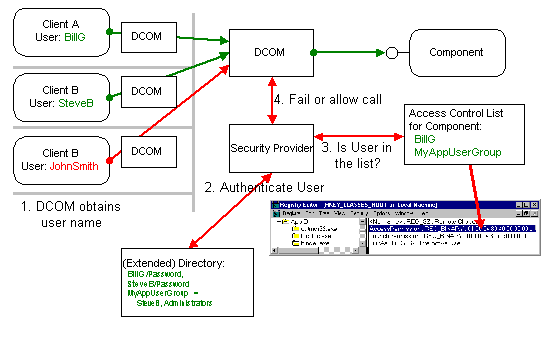
DCOM can make distributed applications secure without any security-specific coding or design in either the client or the component. Just as the DCOM programming model hides a component's location, it also hides the security requirements of a component. The same (existing or off-the-shelf) binary code that works in a single-machine environment, where security may be of no concern, can be used in a distributed environment in a secure fashion.
DCOM achieves this security transparency by letting developers and administrators configure the security settings for each component. Just as the Windows NT File System lets administrators set access control lists (ACLs) for files and directories, DCOM stores Access Control Lists for components. These lists simply indicate which users or groups of users have the right to access a component of a certain class. These lists can easily be configured using the DCOM configuration tool (DCOMCNFG) or programmatically using the Windows NT registry and Win32® security functions.
Whenever a client calls a method or creates an instance of a component, DCOM obtains the client's current username associated with the current process (actually the current thread of execution). Windows NT guarantees that this user credential is authentic. DCOM then passes the username to the machine or process where the component is running. DCOM on the component's machine then validates the username again using whatever authentication mechanism is configured and checks the access control list for the component (actually for the first component run in the process containing the component. For details, see the "DCOM Architecture" White Paper.) If the client's username is not included in this list (either directly or indirectly as a member of a group of users), DCOM simply rejects the call before the component is ever involved. This default security mechanism is completely transparent to both the client and the component and is highly optimized. It is based on the Windows NT security framework, which is probably one of the most heavily used (and optimized!) parts of the Windows NT operating system: on each and every access to a file or even to a thread-synchronization primitive like an event or semaphore, Windows NT performs an identical access check. The fact that Windows NT can still compete with and beat the performance of competing operating systems and network operating systems shows how efficient this security mechanism is.

Figure 13 - Security by Configuration
DCOM provides an extremely efficient default security mechanism that lets developers write secure distributed applications without having to worry about security at all. Any security provider supported by Windows NT can be used with DCOM's security mechanism.